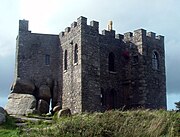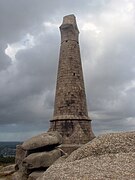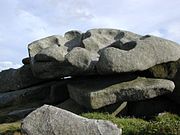Carn Brea, Redruth
| Carn Brea | |
| Cornwall | |
|---|---|
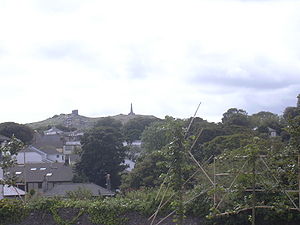 Carn Brea from Redruth | |
| 50°13’19"N, 5°14’49"W | |
Carn Brea is a hill above Redruth and Cambourn in Cornwall, and also the name of a civil parish of 8,000 souls. The summit is crowned with the remains of a Stone Age settlement.
The summit is about one mile southwest of Redruth. The parish named for the hill includes many hamlets and villages, including Bosleake, Brea, Broad Lane, Carn Arthen, Carn Brea Village, Carnkie, Four Lanes, Grillis, Illogan Highway, Pencoys, Penhallick, Piece, Pool, Tolskithy, Tregajorran, Treskillard, Tuckingmill and West Tolgus.
Neolithic settlement
The earliest Neolithic settlement at Carn Brea was a tor enclosure occupied between around 3700 and 3400 BC. A two acre inner enclosure was surrounded by one of eleven acres. The ramparts consisted of stone walls with an earth bank and ditch. Traces of fourteen platforms on which would have stood Neolithic long houses have been found by archaeologists within its ramparts, along with pottery and flint artefacts.[1]
The site was excavated between 1970[2] and 1973[1] by Roger Mercer. A population of 100 to 150 has been suggested. There is evidence that the occupants cleared the surrounding land for farming by burning away the undergrowth and removing stones. The acid soil obliterated any environmental evidence about this. Nearby outcrops of rock suitable for manufacture as axes would have contributed to the village's economy. Edge grinding stones, blanks and incomplete and finished axes found on the site indicate that the inhabitants were accomplished stoneworkers and traded their products with others. The pottery found on the site appears to have been made from gabbroic clay originating from nearly 20 miles to the south in the present day parish of St Keverne. This further suggests a complex economic network in the area.[3]
The 700 flint arrowheads found scattered at the site suggest that Carn Brea may have been attacked at least once.[1] Every timber structure on the site had been burnt, and charcoal was the only organic matter that survived the acid soils. The earthworks themselves may also have been deliberately damaged by an invader.
Iron Age settlement
In the Iron Age the site was reoccupied and minerals were mined from the hillside. A hoard of Kentish gold staters found in the 18th century suggests trade links with the other side of the country at this time.
Landmarks
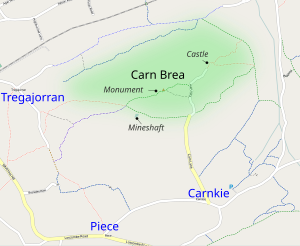
|
Carn Brea Castle
The mediæval Carn Brea Castle stands near the top of the hill. This was originally built in 1379 as a chapel, probably dedicated to St Michael,[4] before being rebuilt in the 18th century by the Basset family as a hunting lodge.[5] It is considered a Folly castle, due to the huge uncut boulders that make up part of its foundations, giving the impression of the building melting into the land.[6]
An East India trading ship was named after Carn Brea Castle, wrecked off the Isle of Wight in 1829 and involved in excise tax fraud.[7]
In the 1980s the abandoned building was converted into a Middle Eastern cuisine restaurant.[8]
Basset Monument
At the highest point of the hill there is a 90-foot high Celtic cross. This is a monument to Francis Basset, 1st Baron de Dunstanville and Basset (1757–1835). Basset, a mine owner, gained his titles for erecting earthworks to defend Plymouth from combined French and Spanish fleets in 1779, and suppressing a miners' "food riot" in 1785.[9] Along with others, he petitioned the House of Lords against slavery in 1828.[10] The monument was erected by public subscription in 1836. It is inscribed "The County of Cornwall to the memory of Francis Lord de Dunstanville and Basset A.D. 1836."[11] 50°13′16″N 5°14′56″W / 50.22111°N 5.24889°W
Cup and Saucer Rock
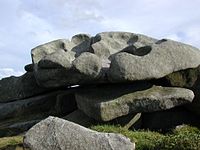
The Cup and Saucer Rock is a large flat rock perched next to the Monument showing several deep basins. This rock has also been called "The Sacrificing Rock" (though with doubtful historical accuracy).[12] 50°13′16″N 5°14′54″W / 50.22111°N 5.24833°W
Smugglers' Cave
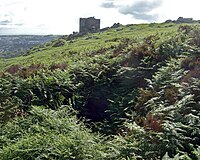
In a depression between the Monument and the Castle are the remains of the "Smugglers' Cave", blocked by the Council in the 1980s with rocks to stop children entering (50.2224583 -5.244833). This tunnel is rumoured to extend from the top of the Carn down into Redruth town, but it is probably an abandoned mine working. It may have been confused with another tunnel from the castle down to St Uny's church which was blocked off for safety reasons around 1970 by the castle owners.
50°13′19″N 5°14′50″W / 50.22194°N 5.24722°W
Saint Euny's Well
This well can be found at the foot of Carn Brea below the Castle and near St Euny's Church. It has a plaque by Carn Brea Parish Trails reading "St Euny Well. Holy well of St Euny visited by the Celtic Missionary 500AD". Stories about the sacred use of this well may be confused with St Euny's Well at Sancreed.
Events
At Easter Redruth Baptist Church erects a lit cross on the outcrop behind the Castle overlooking Redruth. For many years a Christian sunrise service has been held on Easter Sunday.
The Midsummer Eve (St John's Eve, 23 June) bonfire ceremony is held. Prayers are read in Cornish and the bonfire is lit, signalling other fires to be lit at Sennen, Sancreed Beacon, Carn Galver to the Tamar. When only the embers remain, young people leap across them to drive away evil and bring luck.[13]
The Boxing Day meet of the Four Burrow Hunt starts at the top of Carn Brea.[14][15]
Outside links
| ("Wikimedia Commons" has material about Carn Brea, Redruth) |
- Carn Brea Parish Council
- Cornish Archaeological Society
- Roman-Britain.org records of Romano-British Settlement of Carn Brea
References
- ↑ 1.0 1.1 1.2 Roger Mercer (1972). "The Excavation of the Neolithic Settlement, Carn Brea". Cornish Archaeology (Cornwall Archaeological Society) 11.
- ↑ Roger Mercer (1970). "The Neolithic Settlement on Carn Brea: Preliminary Report". Cornish Archaeology (Cornwall Archaeological Society) 9: pp54–62.
- ↑ St. Keverne Local History Society. "The Prehistoric use of Gabbroic Clay from St Keverne". http://www.st-keverne.com/History/arch/gabbroic-clay.php. Retrieved 11/3/12.
- ↑ "About Carn Brea", Carn Brea Protection Group. Retrieved 20 August 2007.
- ↑ "Pictures of Carn Brea", Parish of Saint Illogan. Retrieved 20 August 2007.
- ↑ "Carn Brea Castle", Follies and Monuments, FollyTowers.com. Retrieved 20 August 2007.
- ↑ "Some frauds of a very peculiar and extensive nature have been discovered". The Times. 18 July 1829. p. 4.
- ↑ "Carn Brea Castle, Redruth – Cornwall", Restaurants in Cornwall, EatOutCornwall.com. Retrieved 20 August 2007.
- ↑ "The Bassets of Tehidy", Cornish History Reference Files, CornishWorld.net. Retrieved 20 August 2007.
- ↑ "Parliamentary Intelligence, House of Lords". The Times. 3 June 1828.
- ↑ "Tuesday's Post". Jackson's Oxford Journal. 17 September 1836. "A chaste and elegant monument from the chisel of Westmacott put up in parish of Illogan, Cornwall, to the memory of the late Lord De Dunstanville"
- ↑ Curran, Bob (2005). Celtic Lore & Legend: meet the gods, heroes, kings, fairies, monsters and ghosts of yore. New Page Books. pp. 36. ISBN 1-56414-786-X.
- ↑ Noall, Cyril (1963). The Cornish Midsummer Eve bonfire celebrations. Federation of Old Cornwall Societies. Publications. Federation of Old Cornwall Societies. OCLC 30233069.
- ↑ "Bridgewater Mercury: This could be the last time". Newsquest Media Group. 3 January 2003. http://archive.bridgwatermercury.co.uk/2003/1/3/34093.html. Retrieved 30 October 2006.
- ↑ "Smallholder: Ban? What Ban?". Newsquest Media Group. 28 December 2005. http://archive.smallholder.co.uk/2005/12/28/50889.html. Retrieved 30 October 2006.
- Acton, Bob (2001). Exploring Cornwall's tramway trails, Volume 1 (2 ed.). Landfall. ISBN 978-1-873443-41-5. http://books.google.com/?id=4DD6AAAACAAJ.
- Historic Environment Service (2006) (pdf). Carn Brea, Illogan, Cornwall HEATH Management Assessment. Cornwall County Council. http://212.104.147.54/media/pdf/i/p/Carn_Brea_MA.pdf. Retrieved 19 August 2007.
- Roger Mercer (1981). "Mercer, R.J et al.: Excavations at Carn Brea, Illogan, Cornwall, 1970–73. A Neolithic Fortified Complex of the Third Millennium BC". Cornish Archaeology (Cornwall Archaeological Society) 20.
- Tangye, Michael (1981). Carn Brea: brief history and guide. Dyllansow Truran. ISBN 978-0-907566-12-0. http://books.google.com/?id=vRlIAAAACAAJ.
- Noall, Cyril (2003). The Cornish Midsummer Eve Bonfire Celebrations. Federation of Old Cornwall Societies. ISBN 978-0-902660-31-1. http://books.google.com/?id=6hnJOgAACAAJ.
